JavaScript is disabled for your browser. Some features of this site may not work without it.
Buscar en RiuNet
Listar
Mi cuenta
Estadísticas
Ayuda RiuNet
Admin. UPV
3D GIS TOOLS FOR SUBSOIL MANAGEMENT
Mostrar el registro sencillo del ítem
Ficheros en el ítem
| dc.contributor.author | Herrador, Manuel
|
es_ES |
| dc.contributor.author | Graciano, Alejandro
|
es_ES |
| dc.contributor.author | Feito, Francisco Ramón
|
es_ES |
| dc.contributor.author | Ortega, Lidia
|
es_ES |
| dc.date.accessioned | 2017-07-21T08:41:17Z | |
| dc.date.available | 2017-07-21T08:41:17Z | |
| dc.date.issued | 2016-10-27 | |
| dc.identifier.isbn | 9788490484555 | |
| dc.identifier.uri | http://hdl.handle.net/10251/85585 | |
| dc.description.abstract | [EN] Applications of Geographical Information Systems (GIS) on several archaeology fields have been increasing during the last years. Recent approaches in these technologies make possible to work with even more realistic 3D models with the so-called GIS 3D. However, these systems are currently far from being the perfect tool to integrate the subsoil management in Arqueology. In this paper we focus on the state of the art in 3D GIS for subsoil management as well as the hybrid subsoil model for 3D data management. | es_ES |
| dc.description.abstract | [ES] Las aplicaciones de los Sistemas de Información Geográficos (SIG) en muchos campos de la Arqueología se han ido incrementando en los últimos años. Las nuevas propuestas en estos sistemas permiten trabajar con modelos cada vez más parecidos a la realidad con los denominados SIG 3D. Sin embargo, estos sistemas actualmente distan de ser la herramienta ideal para el manejo del subsuelo en Arqueología. En este artículo nos centramos en el estado del arte en los SIG 3D para manejo del subsuelo y también en un nuevo modelo de datos en 3D, el modelo híbrido de integración de información espacial. | es_ES |
| dc.format.extent | 4 | es_ES |
| dc.language | Inglés | es_ES |
| dc.publisher | Editorial Universitat Politècnica de València | es_ES |
| dc.relation.ispartof | 8th International congress on archaeology, computer graphics, cultural heritage and innovation | es_ES |
| dc.rights | Reconocimiento - No comercial - Sin obra derivada (by-nc-nd) | es_ES |
| dc.subject | Data acquisition | es_ES |
| dc.subject | Photogrammetry | es_ES |
| dc.subject | Remote sensing | es_ES |
| dc.subject | Documentation | es_ES |
| dc.subject | Cultural heritage | es_ES |
| dc.subject | Digitisation | es_ES |
| dc.subject | 3D modelling | es_ES |
| dc.subject | Virtual archaeology | es_ES |
| dc.subject | Virtual museums | es_ES |
| dc.subject | Virtual exhibitions | es_ES |
| dc.subject | Gaming | es_ES |
| dc.subject | Collaborative environments | es_ES |
| dc.subject | Internet technology | es_ES |
| dc.subject | Social media | es_ES |
| dc.subject | Architecture | es_ES |
| dc.title | 3D GIS TOOLS FOR SUBSOIL MANAGEMENT | es_ES |
| dc.type | Capítulo de libro | es_ES |
| dc.type | Comunicación en congreso | es_ES |
| dc.identifier.doi | 10.4995/arqueologica8.2015.3227 | |
| dc.rights.accessRights | Abierto | es_ES |
| dc.description.bibliographicCitation | Herrador, M.; Graciano, A.; Feito, FR.; Ortega, L. (2016). 3D GIS TOOLS FOR SUBSOIL MANAGEMENT. En 8th International congress on archaeology, computer graphics, cultural heritage and innovation. Editorial Universitat Politècnica de València. 277-280. https://doi.org/10.4995/arqueologica8.2015.3227 | es_ES |
| dc.description.accrualMethod | OCS | es_ES |
| dc.relation.conferencename | ARQUEOLÓGICA 2.0 - 8th International Congress on Archaeology, Computer Graphics, Cultural Heritage and Innovation | es_ES |
| dc.relation.conferencedate | September 05-07,2016 | es_ES |
| dc.relation.conferenceplace | Valencia, Spain | es_ES |
| dc.relation.publisherversion | http://ocs.editorial.upv.es/index.php/arqueologica20/arqueologica8/paper/view/3227 | es_ES |
| dc.description.upvformatpinicio | 277 | es_ES |
| dc.description.upvformatpfin | 280 | es_ES |
| dc.type.version | info:eu-repo/semantics/publishedVersion | es_ES |
| dc.relation.pasarela | OCS\3227 | es_ES |








